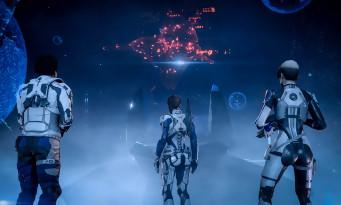 Remember, at the end of Mass Effect 3, the Andromeda Initiative sent four Arks (Picard ships stuffed with frozen colonists) into a new galaxy. The objective was clear: to allow Humanity and the other races of the Milky Way to find a cozy little nest if ever things got really bad with the Collectors. On the program: a flight of more than 600 years towards several planets of the galaxy studied from afar and whose results indicate that they would be "Golden Worlds", that is to say paradisiacal planets perfect for colonization. Unfortunately, in the half-millennium spent traveling, a lot of things have changed once you get there. The planets prove to be inhospitable, so you have to search for new places to settle. This exploration is the job of our new hero, Ryder, a pioneer who can obviously be customized from A to Z at the start of the game. For our part, we preferred to opt for the pre-established characters with the choice between Scott Ryder or Sarah Ryder. The two are brother and sister, so depending on the player's choice, the second character will be an NPC for the rest of the adventure. Concretely, as a pioneer, the role of the player is therefore to explore the galaxy in search of sites to colonize, but also to establish diplomatic relations with the various factions present; and of course to fight against those who would not agree with this philosophy of life. With Andromeda, BioWare therefore takes the opposite view of the first episodes since Humans no longer have to repel an invading alien race, since they become the invading race. This change of point of view is quite welcome insofar as it allows new situations, particularly those of having to face unwelcoming locals, because burned by their previous encounters with other races inhabiting the universe.
Remember, at the end of Mass Effect 3, the Andromeda Initiative sent four Arks (Picard ships stuffed with frozen colonists) into a new galaxy. The objective was clear: to allow Humanity and the other races of the Milky Way to find a cozy little nest if ever things got really bad with the Collectors. On the program: a flight of more than 600 years towards several planets of the galaxy studied from afar and whose results indicate that they would be "Golden Worlds", that is to say paradisiacal planets perfect for colonization. Unfortunately, in the half-millennium spent traveling, a lot of things have changed once you get there. The planets prove to be inhospitable, so you have to search for new places to settle. This exploration is the job of our new hero, Ryder, a pioneer who can obviously be customized from A to Z at the start of the game. For our part, we preferred to opt for the pre-established characters with the choice between Scott Ryder or Sarah Ryder. The two are brother and sister, so depending on the player's choice, the second character will be an NPC for the rest of the adventure. Concretely, as a pioneer, the role of the player is therefore to explore the galaxy in search of sites to colonize, but also to establish diplomatic relations with the various factions present; and of course to fight against those who would not agree with this philosophy of life. With Andromeda, BioWare therefore takes the opposite view of the first episodes since Humans no longer have to repel an invading alien race, since they become the invading race. This change of point of view is quite welcome insofar as it allows new situations, particularly those of having to face unwelcoming locals, because burned by their previous encounters with other races inhabiting the universe.
THROUGH THE NEBULAR CHAIN!
 Unfortunately, you soon realize that BioWare has recycled a lot of stuff, including the main idea that an ancient, highly advanced alien civilization left its ultra-advanced technology lying around all over the place. After more than 2.5 million light years of travel, we find ourselves with a kind of central government inhabiting a space station, the Nexus, which looks a lot like the old Citadel. Similarly, each known race has its ark. We therefore find the Salarians, the Asari and the Turians, but also the Krogans who have embedded themselves a little on each ark. Only three races appear: the Angara (a local people), the Kert (the nasty aliens of the game), but also a few robots that vaguely replace the Geths. This gives us the impression that Andromeda is quite empty of life, given the multiple races each with their well-developed history that we could see in the initial trilogy. Moreover, this use of existing races is found in the composition of the crew of your ship, the Tempest, which ultimately includes a character of each species, with the exception of the evil Kert. We will even find a Turian wearing augmented reality glasses, just like Garrus. Inevitably, faced with the hyper-charismatic cast of the first trilogy, we feel a bit alone, Ryder being ultimately one of the only ones to have a real personality with Peebee, a very loud-mouthed young Asari. As time goes by, you realize the lack of character to the point that all your little crew finally get along quite well, whatever your choices or preferences. We regret the presence of a slightly different character, like the Krogan Wrex who wanted to blow up the team in the original trilogy.
Unfortunately, you soon realize that BioWare has recycled a lot of stuff, including the main idea that an ancient, highly advanced alien civilization left its ultra-advanced technology lying around all over the place. After more than 2.5 million light years of travel, we find ourselves with a kind of central government inhabiting a space station, the Nexus, which looks a lot like the old Citadel. Similarly, each known race has its ark. We therefore find the Salarians, the Asari and the Turians, but also the Krogans who have embedded themselves a little on each ark. Only three races appear: the Angara (a local people), the Kert (the nasty aliens of the game), but also a few robots that vaguely replace the Geths. This gives us the impression that Andromeda is quite empty of life, given the multiple races each with their well-developed history that we could see in the initial trilogy. Moreover, this use of existing races is found in the composition of the crew of your ship, the Tempest, which ultimately includes a character of each species, with the exception of the evil Kert. We will even find a Turian wearing augmented reality glasses, just like Garrus. Inevitably, faced with the hyper-charismatic cast of the first trilogy, we feel a bit alone, Ryder being ultimately one of the only ones to have a real personality with Peebee, a very loud-mouthed young Asari. As time goes by, you realize the lack of character to the point that all your little crew finally get along quite well, whatever your choices or preferences. We regret the presence of a slightly different character, like the Krogan Wrex who wanted to blow up the team in the original trilogy.
DORCEL EFFECT
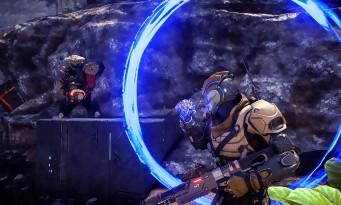 The surest way to entertain yourself with this cast is by using the hero's crazy seduction abilities. Ryder will be able to flirt like an animal, and by doing it right, the Tempest will be able to become hotter than a Marc Dorcel film set. Straight, gay, cross-species, BioWare has everything planned to satisfy your baser instincts, including including real sex scenes worthy of good soft porn. On this point, there has clearly been progress since the first trilogy. These incessant comparisons, just like the close-ups on the interlocutors, make us confirm what you already know: the facial animations of Mass Effect Andromeda suck. Really. The fault of the Frostbite engine which has never really shone on this point. Fortunately, the problem is only shocking when it is addressed to Humans, the disaster being much less visible on the different alien races, especially since we are entitled to excellent voice-acting, even on the characters the most insignificant. The care given to the dialogues is also very present thanks to the new dialogue system, which now offers 4 response options instead of the Manichaean system of the initial trilogy.
The surest way to entertain yourself with this cast is by using the hero's crazy seduction abilities. Ryder will be able to flirt like an animal, and by doing it right, the Tempest will be able to become hotter than a Marc Dorcel film set. Straight, gay, cross-species, BioWare has everything planned to satisfy your baser instincts, including including real sex scenes worthy of good soft porn. On this point, there has clearly been progress since the first trilogy. These incessant comparisons, just like the close-ups on the interlocutors, make us confirm what you already know: the facial animations of Mass Effect Andromeda suck. Really. The fault of the Frostbite engine which has never really shone on this point. Fortunately, the problem is only shocking when it is addressed to Humans, the disaster being much less visible on the different alien races, especially since we are entitled to excellent voice-acting, even on the characters the most insignificant. The care given to the dialogues is also very present thanks to the new dialogue system, which now offers 4 response options instead of the Manichaean system of the initial trilogy.
These incessant comparisons, just like the close-ups on the interlocutors, make us confirm what you already know: the facial animations of Mass Effect Andromeda suck. Really. The fault of the Frostbite engine which has never really shone on this point.
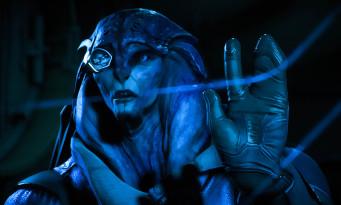 If this system makes it possible to have many options of approach, it is actually less impacting, BioWare not being able to carry out as many scenario alternatives as there are answers. Instead of the choice "good guy / bad guy" having a real impact on the scenario, we end up with an extensive menu but which still lacks flavor, the consequences being almost negligible. This lack of influence in the choices is also one of the worst aspects of Mass Effect Andromeda. Whatever we do, we now have much less latitude than before. Even the end of the game seems to be impervious to the choices made during the adventure, the only impact we could see being the presence – or not – of your sidekicks depending on your relationship with them. Moreover, without wanting to spoiler, know that if the writing was widely criticized (especially a rather bad exchange at the start of the game with suspiciously long pauses between each reply), it is only about the first hours of play. Once the adventure is well under way, we find all the talent of BioWare which distills us a very interesting scenario with well chiseled dialogues.
If this system makes it possible to have many options of approach, it is actually less impacting, BioWare not being able to carry out as many scenario alternatives as there are answers. Instead of the choice "good guy / bad guy" having a real impact on the scenario, we end up with an extensive menu but which still lacks flavor, the consequences being almost negligible. This lack of influence in the choices is also one of the worst aspects of Mass Effect Andromeda. Whatever we do, we now have much less latitude than before. Even the end of the game seems to be impervious to the choices made during the adventure, the only impact we could see being the presence – or not – of your sidekicks depending on your relationship with them. Moreover, without wanting to spoiler, know that if the writing was widely criticized (especially a rather bad exchange at the start of the game with suspiciously long pauses between each reply), it is only about the first hours of play. Once the adventure is well under way, we find all the talent of BioWare which distills us a very interesting scenario with well chiseled dialogues.
THE KISS KOOL EFFECT
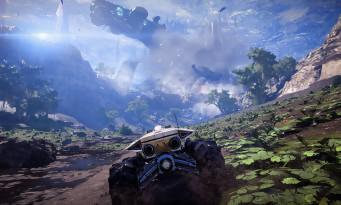 Overall, the main and semi-main quests are of good quality, bringing their share of emotion and pleasant activities. As quite often in RPGs, the further away from the main plot, the simpler and more redundant the quests become. We will thus have a lot of small FedEx quests where we will have to go back and forth between different NPCs. Fortunately, nothing is mandatory and the apparent disconnection that we saw between our actions and the end of the game suggests that BioWare did not want to penalize players who do not wish to platinum the game before being able to finish the main frame. For the sake of clarity, each quest is identified in a copious but clear log, so that we are not drowned under the mass of available activities. You can also choose the quests directly from the map, in order to play them in order of geographical proximity and thus avoid multiplying the trips. So much of the game boils down to exploring new planets and then clearing them before they can accommodate a new Andromeda Initiative outpost, which will then be populated with freshly thawed settlers. Servicing will go through contact with the natives, but also by visiting mysterious alien monoliths that can modify the climate. These act as dungeons and offer puzzles generally based on Sudoku. A fairly well-made system that contrasts with the rest of the game, and which will not go so far as to fry your brain thanks to good accessibility. Moreover, once the planet is serviced, you will be entitled to a mini-boss in order to be able to serenely draw in the heap after so much reflection. These planets are nicely modeled, much less empty than in the initial trilogy and quite open even if we prefer to speak of a semi-open world than a real open-world. BioWare remains faithful to its science fiction approach with a Tatooine-style desert planet, a Hoth-like frozen planet, a low-gravity asteroid, or even an impenetrable jungle that you will have to explore on foot. To stroll serenely in more open areas, we have the Nomad, a large six-wheeled machine with a fairly friendly behavior.
Overall, the main and semi-main quests are of good quality, bringing their share of emotion and pleasant activities. As quite often in RPGs, the further away from the main plot, the simpler and more redundant the quests become. We will thus have a lot of small FedEx quests where we will have to go back and forth between different NPCs. Fortunately, nothing is mandatory and the apparent disconnection that we saw between our actions and the end of the game suggests that BioWare did not want to penalize players who do not wish to platinum the game before being able to finish the main frame. For the sake of clarity, each quest is identified in a copious but clear log, so that we are not drowned under the mass of available activities. You can also choose the quests directly from the map, in order to play them in order of geographical proximity and thus avoid multiplying the trips. So much of the game boils down to exploring new planets and then clearing them before they can accommodate a new Andromeda Initiative outpost, which will then be populated with freshly thawed settlers. Servicing will go through contact with the natives, but also by visiting mysterious alien monoliths that can modify the climate. These act as dungeons and offer puzzles generally based on Sudoku. A fairly well-made system that contrasts with the rest of the game, and which will not go so far as to fry your brain thanks to good accessibility. Moreover, once the planet is serviced, you will be entitled to a mini-boss in order to be able to serenely draw in the heap after so much reflection. These planets are nicely modeled, much less empty than in the initial trilogy and quite open even if we prefer to speak of a semi-open world than a real open-world. BioWare remains faithful to its science fiction approach with a Tatooine-style desert planet, a Hoth-like frozen planet, a low-gravity asteroid, or even an impenetrable jungle that you will have to explore on foot. To stroll serenely in more open areas, we have the Nomad, a large six-wheeled machine with a fairly friendly behavior.
So much of the game boils down to exploring new planets and then clearing them before they can accommodate a new Andromeda Initiative outpost, which will then be populated with freshly thawed settlers.
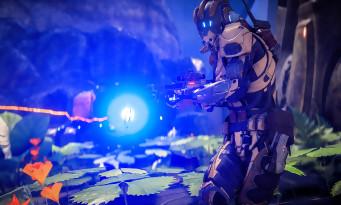 At the wheel of the Nomad, you can rush in four-wheel drive mode, engage six-wheel drive mode to climb steep slopes, and even use the boost or rockets to accelerate and make small jumps. Driving is really impacted by the terrain since you can slide on the ice, or make crazy jumps in micro-gravity conditions. On this point, BioWare has done a good job because the exploration of planets never becomes boring, mainly thanks to the intelligent use of many capsules dropped from the Tempest. These serve as a fast-travel point, which avoids the incessant back and forth once the exploration phase is over. This gain in accessibility can also be seen with intergalactic exploration where you just have to go next to a planet to know immediately if something interesting is there. No more spending hours scanning everything by hand to get ore. However, those who love to mine will find a similar system on board the Nomad, which has a geological scanner allowing you to know the resources hidden under your feet. All that remains is to send a drone to recover what interests you. All this will therefore be used to craft armor, weapons and even improvements for the Nomad in order to be serene during combat. The latter are particularly successful thanks to the new approach taken by the studio. First of all, Ryder can now hide behind just about any surface via a fairly efficient automatic system. As soon as the weapon is out and one approaches a vertical surface, Ryder will huddle behind it, automatically crouching if need be. From this hideout you can either shoot blind or go out to shoulder your weapon, a bit like in Gears of War. The game offers an unprecedented verticality that we apprehend thanks to the jetpack with which Ryder is equipped.
At the wheel of the Nomad, you can rush in four-wheel drive mode, engage six-wheel drive mode to climb steep slopes, and even use the boost or rockets to accelerate and make small jumps. Driving is really impacted by the terrain since you can slide on the ice, or make crazy jumps in micro-gravity conditions. On this point, BioWare has done a good job because the exploration of planets never becomes boring, mainly thanks to the intelligent use of many capsules dropped from the Tempest. These serve as a fast-travel point, which avoids the incessant back and forth once the exploration phase is over. This gain in accessibility can also be seen with intergalactic exploration where you just have to go next to a planet to know immediately if something interesting is there. No more spending hours scanning everything by hand to get ore. However, those who love to mine will find a similar system on board the Nomad, which has a geological scanner allowing you to know the resources hidden under your feet. All that remains is to send a drone to recover what interests you. All this will therefore be used to craft armor, weapons and even improvements for the Nomad in order to be serene during combat. The latter are particularly successful thanks to the new approach taken by the studio. First of all, Ryder can now hide behind just about any surface via a fairly efficient automatic system. As soon as the weapon is out and one approaches a vertical surface, Ryder will huddle behind it, automatically crouching if need be. From this hideout you can either shoot blind or go out to shoulder your weapon, a bit like in Gears of War. The game offers an unprecedented verticality that we apprehend thanks to the jetpack with which Ryder is equipped.
JUNIOR SCIENCE & LIFE
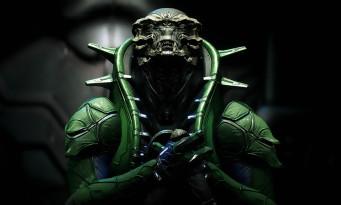 We can thus dash like crazy, jump, climb and even stay in the air for a few moments in order to weigh down enemies who camp a little too much in their hideout. The fights are nervous, and the AI is really good, not hesitating to bypass you cheerfully if it can, just to kill you. Similarly, the reactions in combat are quite believable with enemies hiding when you shoot them, and taking out the grenades to continue fighting once cornered. To defeat them, there is a very varied arsenal of weapons, as well as the traditional Tech and Biotic powers that can be equipped on Ryder. Far from the tough choice of previous episodes, Mass Effect Andromeda offers the possibility of creating different profiles (with three powers to choose from per profile), knowing that you can switch from one perk to another in the middle of a fight, although it is at the cost of a small cooldown. The art of war hasn't evolved too much, with the right combinations of powers still offering the possibility of unleashing devastating combos. This system is also somewhat limited, since we cannot give specific orders to our allies apart from placement instructions. We will therefore be alone to perform these combos, limited to the three powers of the palette used. That said, the allies are not useless, they are even devilishly effective if you think about assigning their skill points to them. The fights avoid the trap of repetition thanks to a fairly varied offer of opponents, each with their own fighting style and their weaknesses. While headshots often work very well, some enemies have weak points elsewhere. It will then be necessary to discover them and optimize everything, otherwise the impression of dealing with bags with PV will arrive quickly. Finally, to emancipate yourself from these AIs and do combos with several people, we will go to the very good multiplayer which offers specific missions that are very profitable in credits. Don't panic if you're the lonely type, we can send AI to do these missions and still get the rewards.
We can thus dash like crazy, jump, climb and even stay in the air for a few moments in order to weigh down enemies who camp a little too much in their hideout. The fights are nervous, and the AI is really good, not hesitating to bypass you cheerfully if it can, just to kill you. Similarly, the reactions in combat are quite believable with enemies hiding when you shoot them, and taking out the grenades to continue fighting once cornered. To defeat them, there is a very varied arsenal of weapons, as well as the traditional Tech and Biotic powers that can be equipped on Ryder. Far from the tough choice of previous episodes, Mass Effect Andromeda offers the possibility of creating different profiles (with three powers to choose from per profile), knowing that you can switch from one perk to another in the middle of a fight, although it is at the cost of a small cooldown. The art of war hasn't evolved too much, with the right combinations of powers still offering the possibility of unleashing devastating combos. This system is also somewhat limited, since we cannot give specific orders to our allies apart from placement instructions. We will therefore be alone to perform these combos, limited to the three powers of the palette used. That said, the allies are not useless, they are even devilishly effective if you think about assigning their skill points to them. The fights avoid the trap of repetition thanks to a fairly varied offer of opponents, each with their own fighting style and their weaknesses. While headshots often work very well, some enemies have weak points elsewhere. It will then be necessary to discover them and optimize everything, otherwise the impression of dealing with bags with PV will arrive quickly. Finally, to emancipate yourself from these AIs and do combos with several people, we will go to the very good multiplayer which offers specific missions that are very profitable in credits. Don't panic if you're the lonely type, we can send AI to do these missions and still get the rewards.
 Technically, Mass Effect Andromeda always remains contrasting. Graphically, having tested the game on PC, we had no complaints. The game runs flawlessly on a graphics card with more than 3GB of VRAM, with no framerate jumps or issues. On a GTX 970, we managed to run the game fully with all options, proof of the good work done by BioWare. On consoles, the result is lower with a lot of framerate drops, Zelda Breath of the Wild players will feel right at home. On the other hand, in our test version which does not yet have the updates, the game still offers a lot of glitches, from the simple little collision bug to the big more annoying bug which prevents us from carrying out certain quests. We were never able to board the Turian ark to carry out our mission there, for example. Let's hope that these problems will be corrected by the developers before the game is released. We also noticed an uneven level on the animations. While some are very bad, others are excellent, and some details even caught our eye, such as the traces left by the Nomad in the ground, or certain climatic effects.
Technically, Mass Effect Andromeda always remains contrasting. Graphically, having tested the game on PC, we had no complaints. The game runs flawlessly on a graphics card with more than 3GB of VRAM, with no framerate jumps or issues. On a GTX 970, we managed to run the game fully with all options, proof of the good work done by BioWare. On consoles, the result is lower with a lot of framerate drops, Zelda Breath of the Wild players will feel right at home. On the other hand, in our test version which does not yet have the updates, the game still offers a lot of glitches, from the simple little collision bug to the big more annoying bug which prevents us from carrying out certain quests. We were never able to board the Turian ark to carry out our mission there, for example. Let's hope that these problems will be corrected by the developers before the game is released. We also noticed an uneven level on the animations. While some are very bad, others are excellent, and some details even caught our eye, such as the traces left by the Nomad in the ground, or certain climatic effects.


























